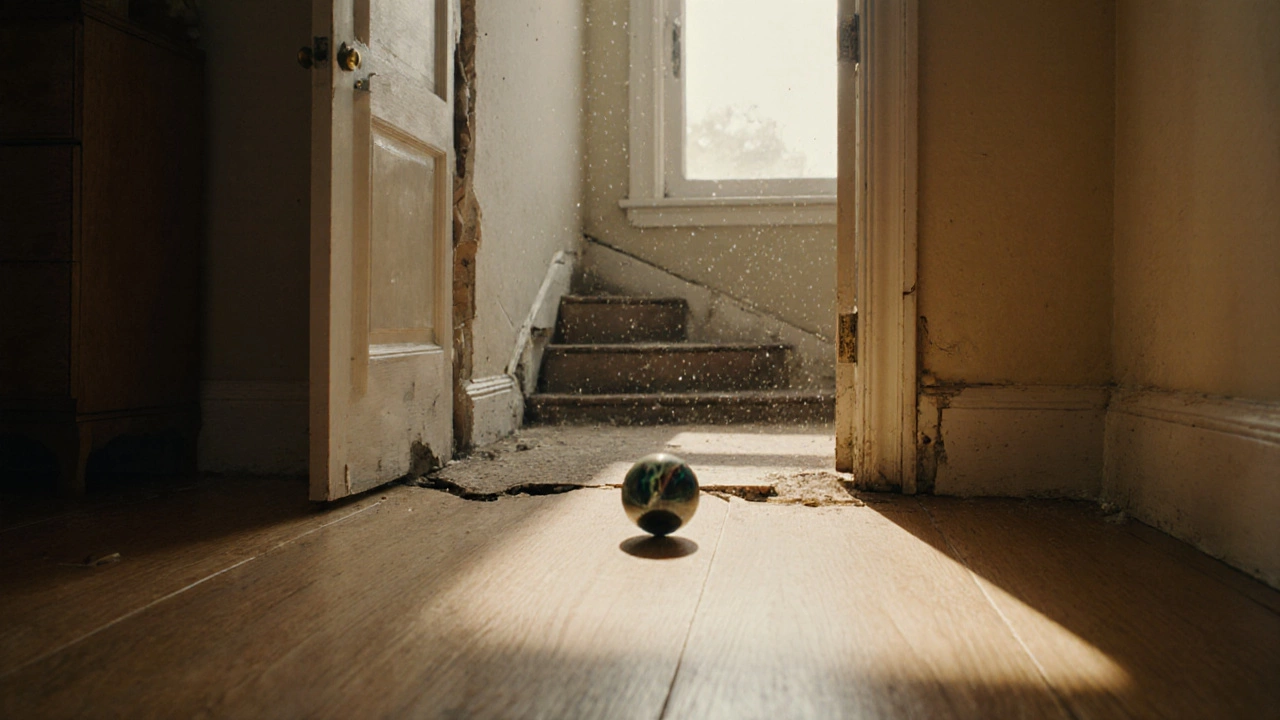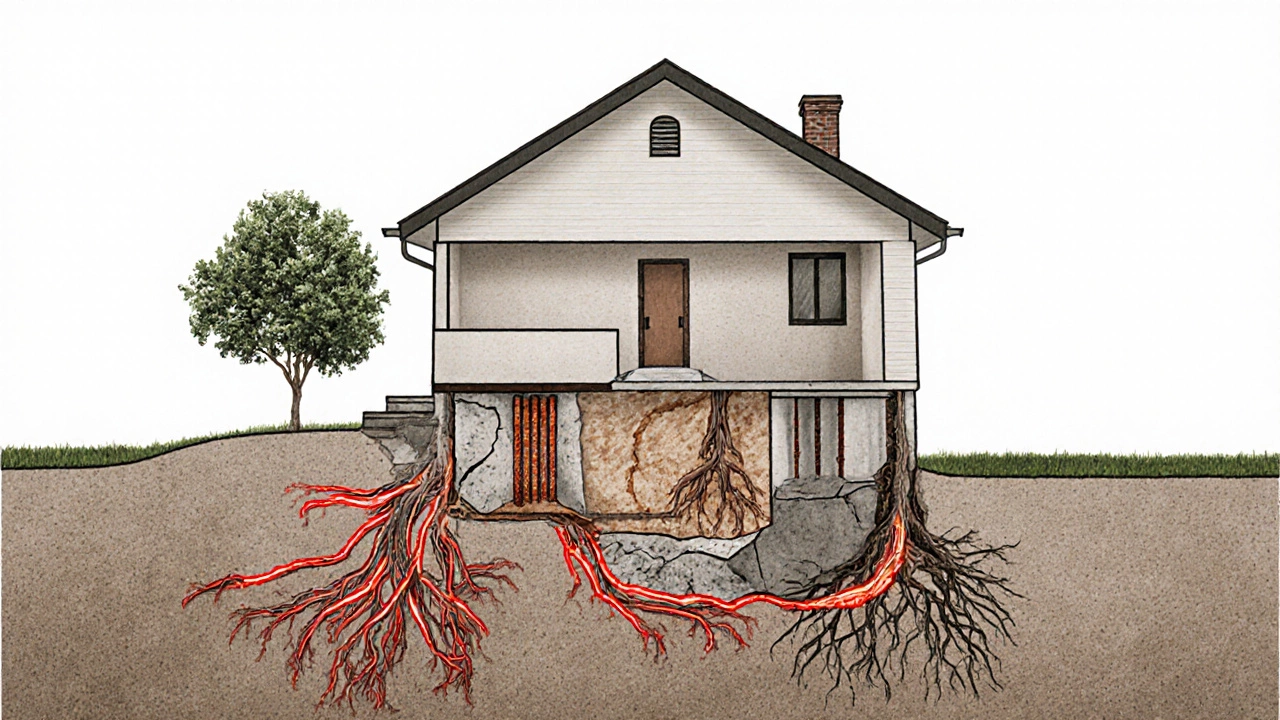Can a House Collapse from Foundation Issues? What You Need to Know
 Nov, 8 2025
Nov, 8 2025
Foundation Health Assessment Tool
Is Your Foundation at Risk?
Answer these questions about your home's condition to identify potential foundation issues.
Your foundation assessment result will appear here...
It’s a scary thought: your home, the place you feel safest, suddenly sinking, cracking, or worse-collapsing. And it’s not just a movie trope. Houses can collapse from foundation issues. Not every crack means disaster, but ignoring serious foundation problems is like ignoring a heartbeat that’s fading. In Wellington, where earthquakes are part of life and clay soils shift with the rain, foundation failure isn’t rare-it’s a quiet emergency waiting to happen.
How Foundations Actually Fail
Your home’s foundation isn’t just a slab of concrete. It’s the base that holds up every wall, every floor, every ceiling. When it moves, everything above it follows. Foundations fail in predictable ways:- Settling: The soil beneath shifts over time, especially if it’s clay-heavy or poorly compacted. This causes uneven sinking, not just one corner dropping.
- Water damage: Poor drainage, broken pipes, or heavy rain saturates the soil. Wet soil expands, then shrinks as it dries. This push-pull cracks concrete and twists support beams.
- Erosion: Water washes away soil under footings. Without support, the foundation drops suddenly.
- Tree roots: Large trees near the house can dry out soil or push against foundations, especially in shallow, rocky ground.
- Earthquakes: In Wellington, even minor tremors can worsen existing cracks or shift poorly built foundations.
These aren’t abstract problems. A 2023 report from the New Zealand Building Performance Association showed that 37% of homes built before 1980 in the Wellington region had measurable foundation movement. Half of those had signs of structural stress.
Signs Your Foundation Is in Danger
You don’t need an engineer to spot warning signs. Look for these red flags:- Doors and windows that stick or won’t close properly, especially if they started jamming all at once.
- Cracks wider than 5mm in brickwork, concrete slabs, or interior drywall-especially if they’re diagonal or stair-stepped.
- Floors that slope noticeably. Try rolling a marble across the floor. If it rolls toward one corner, that’s not normal.
- Gaps between walls and ceilings, or between baseboards and floors.
- Crumbling mortar, exposed rebar, or rust stains on foundation walls.
- Outside, check for soil pulling away from the foundation or standing water pooling near the house after rain.
These aren’t cosmetic. They’re symptoms of movement. And movement doesn’t stop unless you fix the root cause.
When Does a Foundation Lead to Collapse?
Not every cracked foundation leads to collapse. But collapse happens when:- Supports are completely gone-like when soil washes out from under a footing and the wall drops 10cm or more in one spot.
- Load-bearing walls lose their connection to the foundation and start tilting outward.
- Multiple structural elements fail at once. A cracked wall, a sinking floor, and a leaning chimney together mean the system is breaking down.
There’s a myth that homes collapse overnight. That’s rare. Most collapses happen after months or years of warning signs being ignored. A house in Lower Hutt collapsed in 2022 after a homeowner noticed a 2cm crack for three years, then bought new furniture and didn’t think twice. The next heavy rainstorm turned the soil into mud, and the corner of the house dropped 15cm. No one was hurt-but the house was a total loss.

What Makes Some Houses More at Risk?
Not all homes are equally vulnerable. Here’s what increases risk:| Factor | Why It Matters | Typical in Wellington Homes? |
|---|---|---|
| Age (pre-1970) | Older homes used weaker concrete, no steel reinforcement, and shallow footings. | Yes-over 40% of homes here were built before 1970 |
| Clay soil | Expands when wet, shrinks when dry. Causes constant pressure on foundations. | Yes-most of the Hutt Valley and Porirua have heavy clay |
| Poor drainage | Water pools near the foundation, softens soil, causes erosion. | Common in older subdivisions without proper gutter systems |
| Tree roots within 3 meters | Can dry out soil or physically push against foundations. | Very common in suburban yards with large pohutukawa or maple trees |
| No foundation waterproofing | Moisture seeps into concrete, corrodes steel, weakens structure over time. | Most homes built before 1990 lack this |
What to Do If You Suspect Foundation Problems
Don’t panic. Don’t wait. Don’t try to patch it with epoxy or paint.- Document everything. Take photos of cracks, measure their width with a ruler, and note where they appear. Write down when you noticed changes.
- Check your drainage. Make sure gutters are clean, downspouts extend at least 2 meters from the house, and the ground slopes away from the foundation.
- Call a structural engineer-not just a contractor. A foundation repair company might push you into expensive fixes. An engineer gives you an unbiased report. In New Zealand, look for someone registered with Engineering New Zealand.
- Get a written assessment. A proper report should include soil tests, level measurements, and a risk rating. Don’t accept verbal opinions.
- Don’t delay repairs. Foundation issues get worse. A $5,000 underpinning job today can become a $50,000 rebuild tomorrow.

Common Myths About Foundation Collapse
- Myth: "My house is on a slab, so it’s safe." Truth: Slab foundations can sink just as badly as raised ones. In fact, they’re harder to repair.
- Myth: "Small cracks are normal." Truth: Hairline cracks (under 1mm) from curing are normal. Anything wider than 3mm is a red flag.
- Myth: "I can fix it with a DIY kit." Truth: Epoxy injections and sealants only hide the problem. They don’t stop movement.
- Myth: "Insurance will cover it." Truth: Most home insurance policies in New Zealand exclude damage from gradual ground movement or poor drainage. Earthquake insurance doesn’t cover foundation settling unless it’s from a quake.
How to Prevent Foundation Failure
Prevention is cheaper than repair:- Keep gutters clean and downspouts extended.
- Water your lawn evenly-don’t let one side of your yard dry out completely.
- Remove large trees within 3 meters of the house if they’re on clay soil.
- Install a moisture barrier under the house if you have a crawl space.
- Have your foundation inspected every 5 years if your home is older than 30 years.
There’s no magic fix. But staying alert and acting early can save your home-and your peace of mind.
Can a house collapse from foundation issues?
Yes, a house can collapse from foundation issues-but it’s rare and usually happens after years of ignored warning signs. Collapse occurs when supports fail completely, such as when soil washes out from under footings, walls tilt, or multiple structural elements break down. Most homes show clear signs long before collapse, like large cracks, sloping floors, or jammed doors. Acting early can prevent disaster.
How do I know if my foundation crack is serious?
A crack wider than 5mm, especially if it’s diagonal, stair-stepped, or growing over time, is serious. Cracks that run through both the foundation and the wall above it, or that are accompanied by sloping floors or sticking doors, indicate structural movement. Hairline cracks under 1mm are usually harmless shrinkage cracks. If you’re unsure, get a professional inspection.
Will insurance cover foundation collapse?
Most standard home insurance policies in New Zealand do not cover foundation damage caused by gradual soil movement, poor drainage, or tree roots. Earthquake insurance only covers damage directly caused by seismic events, not settling or erosion. You’ll need to pay for repairs yourself unless the damage resulted from a sudden, insured event like a burst pipe.
Can I fix foundation issues myself?
No. DIY kits for sealing cracks or injecting epoxy only mask the problem. They don’t stop the underlying movement-whether from water, soil shift, or erosion. Foundation repair requires structural engineering, underpinning, or soil stabilization, which needs licensed professionals. Attempting to fix it yourself can make the problem worse and cost more in the long run.
How much does foundation repair cost in New Zealand?
Costs vary based on damage and home size. Minor repairs like crack sealing and drainage fixes can cost $2,000-$5,000. Major repairs like underpinning or slab jacking range from $15,000 to $50,000. In extreme cases, full foundation replacement can exceed $80,000. Getting multiple quotes and a structural engineer’s report helps avoid overpaying.
Next Steps if You’re Worried
If you’ve noticed any of these signs, here’s your action plan:- Take photos and measurements today.
- Check your gutters and drainage this week.
- Book a structural inspection within the next 30 days.
- Don’t wait for a crack to get bigger. The longer you wait, the more expensive-and dangerous-it becomes.
Your foundation doesn’t scream. It whispers. Listen before it’s too late.
